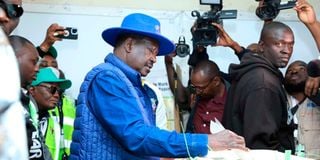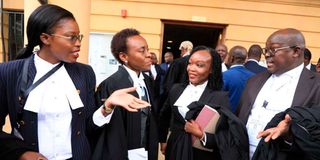Premium
The recurring claims in all of Raila’s poll petitions

Azimio La Umoja One Kenya Coalition presidential candidate Raila Odinga casts his ballot at Old Kibra polling station in Nairobi on August 9, 2022.
What you need to know:
- Once again, Mr Odinga has asked the Supreme Court to order the IEBC to include rejected ballots when calculating the total votes cast.
- Mr Odinga and the civil society players also argued that the IEBC’s failure to transmit provisional results to the public was a sign of mischief.
- Just like in 2017, Mr Odinga has asked the Supreme Court to look into the variance between votes cast for presidential candidates and those for other elective positions.
On March 9, 2013, the elections agency’s chairperson Issack Hassan declared Uhuru Kenyatta the winner of a heated Presidential election.
Mr Kenyatta had managed 6,173,433 votes against former Prime Minister Raila Odinga’s 5,340,546.
The son of Kenya’s first President had attained 50.51 per cent of the vote, against Mr Odinga’s 43.7 per cent.
Despite the wide margin, Mr Kenyatta dodged a run-off by only 8,100 votes.
Mr Kenyatta had picked William Ruto as his running mate and Mr Odinga had Stephen Kalonzo Musyoka as his.
When Mr Odinga filed a petition challenging the election results, he asked the Supreme Court to order the Independent Electoral and Boundaries Commission (IEBC) to include rejected ballots when calculating the total votes cast.
The move would have likely thrown Mr Kenyatta out of the safe 50 per cent plus one vote path and into a run-off against a formidable candidate.
A decade later, Mr Odinga is in a similar position. The IEBC has declared Dr Ruto the President-elect.
Dr Ruto, the sitting Deputy President, was declared the winner after garnering 7,176,141 votes. Mr Odinga was second with 6,942,930 votes.
Only 69,000 votes stopped the IEBC from ordering a run-off.
Dr Ruto ran on a United Democratic Alliance ticket with Rigathi Gachagua, Mr Kenyatta’s former personal assistant, as his running mate. He was supported by the Kenya Kwanza alliance.
Mr Odinga is on an Azimio la Umoja-One Kenya Alliance ticket with former Justice Minister Martha Karua, a friend-turned-foe then friend again, as his running mate.

Some of Azimio la Umoja lawyers consult during day three of hearings of the presidential petitions at the Supreme Court, Milimani on September 2, 2022.
Rejected ballots
Once again, Mr Odinga has asked the Supreme Court to order the IEBC to include rejected ballots when calculating the total votes cast.
And once again, Senior Counsel Fred Ngatia is representing the declared President-elect and asking the Supreme Court to dismiss Mr Odinga’s request and his petition for nullification of the election.
Siaya Governor and Senior Counsel James Orengo, is leading Mr Odinga’s team.
Mr Odinga’s legal team in 2017 also asked the Supreme Court to order rejected ballots counted among the total votes cast.
In the 2022 petition, the former Premier has argued that even rejected ballots are from people who left their homes to pick a Presidential candidate, and so their vote should count.
Dr Ruto’s team argues that rejected ballots and stray ballots do not express a choice for a candidate and hence should not be added to the total votes cast.
“It’s actually a rejected ballot because a vote is that which is valid which expresses a choice. The same holds true for spoilt ballots, and the same holds true for stray ballots,” Mr Ngatia argued.
Civil society
Just like in 2013, there are members of the civil society that have challenged election results alongside Mr Odinga.
Gladwell Otieno and Zahid Rajan of the Africa Centre for Open Governance (Africog) were the other petitioners that filed petitions challenging the results.
The petitioners argued that there were discrepancies between numbers announced by the IEBC and those on results transmission forms used to tally the final results. This, they argued, cast doubt on the final results.
Mr Odinga and the civil society players also argued that the IEBC’s failure to transmit provisional results to the public was a sign of mischief.
One of their other key prayers in 2013 was that the IEBC failed to ensure that party agents signed results transmission forms.
In all four presidential petitions that Mr Odinga has filed at the Supreme Court in the last four election cycles, he has argued manipulation of result transmission forms.
In 2013, he accused the IEBC of relying on manipulated forms that inflated Mr Kenyatta’s tally.
Five years later, Mr Odinga argued that there were several numerical variances between physical result transmission forms and copies that were uploaded on the IEBC portal.
In 2022, Mr Odinga says that some forms have once again been manipulated and that they do not match with what the elections agency uploaded on its website. He has also accused IEBC chairperson Wafula Chebukati of declaring a winner without results from 27 constituencies.
In 2017, he argued that Mr Chebukati declared a winner before results from 17 constituencies had been factored in.
And just like in 2017, Mr Odinga has asked the Supreme Court to look into the variance between votes cast for presidential candidates and those for other elective positions.
In 2017, the variance was one of the grounds that led to the nullification of the election.




